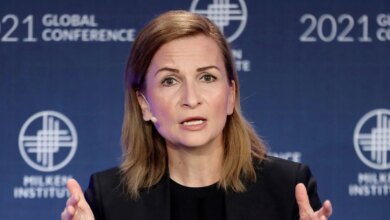As Americans spend, credit card debt is ticking back up

Mastercard Inc. bank cards are displayed on this image illustration taken December 8, 2017. REUTERS/Benoit Tessier/Illustration/File Photograph
NEW YORK, Sept 27 (Reuters) – Early within the pandemic, there have been encouraging and shocking indicators concerning the decline of bank card debt.
Now, that trendline appears to be altering.
Many People stayed at house at first of COVID-19 and didn’t spend like they normally do. Additionally they obtained a number of rounds of emergency money help, serving to to cut away at these credit-card payments, a minimum of briefly.
Spending is ticking again up – and the outcomes are beginning to present up on our month-to-month statements.
Actually, 42% of these with bank card debt, or 59 million People, say they’ve added to their balances because the starting of the pandemic, in keeping with a brand new research by private finance website Bankrate.com.
“Issues are higher for some, however they don’t seem to be higher for everyone,” explains Ted Rossman, Bankrate’s senior trade analyst.
The tip of stimulus checks, expanded unemployment advantages and the eviction moratorium doesn’t bode nicely for debt administration, Rossman added.
This development reversal is mirrored in the newest numbers of the Federal Reserve Financial institution of New York. Its Quarterly Report on Family Debt and Credit score discovered that credit-card payments rose by $17 billion in 2021’s second quarter, to $790 billion nationally. That was the primary uptick after 4 straight quarters of declines.
Additionally headed north had been auto loans, by $33 billion within the quarter, and mortgage debt, by $282 billion. All informed it makes for whole family debt of $14.96 trillion, a quarterly rise of two.1%.
DIFFERENT DEBT, DIFFERENT STRATEGIES
After all, not all debt is similar, nor ought to it routinely be thought of a nasty factor. The rise in mortgage debt will be attributed to many individuals shopping for houses in a scorching actual property market – and with rates of interest close to historic lows, that’s not essentially a priority for family steadiness sheets.
Bank card debt is particularly pernicious, although. It may be very difficult to flee as balances rise to a sure stage, mixed with sky-high curiosity on revolving debt – common charges are presently north of 16%, in keeping with Bankrate. Add in late charges or missed funds, and the cycle is difficult to interrupt.
These issues are highlighted in a latest survey by actual property agency Intelligent. Virtually one in 5 of these with bank card debt, 18%, report having payments over $20,000. In the meantime 40% of those that carry a month-to-month steadiness haven’t been debt-free from bank cards since earlier than 2018, and 15% have been combating it for greater than 15 years.
“We additionally discovered that 57% of individuals had missed a credit-card cost, and nearly all of these had been up to now 12 months,” says Francesca Ortegren, lead researcher for Intelligent. “It might trigger a snowball impact over time, and make it a lot more durable to climb out.”
Power debt could make individuals really feel fairly bleak. A 3rd of these with bank card debt suppose it can take a minimum of a few years to pay it off, and 20% say three years or extra, in keeping with Intelligent. Most miserable of all, 3% suppose it can by no means be attainable.
CHARTING A WAY OUT
To make sure, there are glimmers of fine information within the debt information. Regardless that bank card payments are as soon as once more headed again up, the early-pandemic declines implies that whole quantities are nonetheless $140 billion under the top of 2019’s ranges, in keeping with the Federal Reserve Financial institution of New York. And scholar mortgage debt really dropped within the second quarter of 2021, by $14 billion.
In the meantime private financial savings charges are nonetheless elevated, in comparison with historic norms. And debt delinquencies and defaults are comparatively modest, notes Bankrate’s Rossman — which is considerably shocking, given the size and breadth of our ongoing pandemic disaster.
What Rossman worries about: That our early-pandemic frugality will fall by the wayside, and the urge to get out and spend after being cooped up for thus lengthy will throw no matter progress we have now made into reverse.
As an alternative, People needs to be proactive. He suggests: Make the most of the rising variety of 0% card balance-transfer gives, companion with nonprofit credit score counselors like Cash Administration Worldwide or GreenPath, or repay high-rate playing cards with a lower-rate private mortgage.
“It could be good if we might preserve decrease balances as part of our future,” Rossman says. “You don’t wish to throw that every one away and run these balances proper again up – as a result of that is very costly debt.”
Enhancing by Lauren Younger and Diane Craft
Observe us @ReutersMoney or at <a href=”http://www.reuters.com/finance/personal-finance.” goal=”_blank”>http://www.reuters.com/finance/personal-finance.</a>
:





